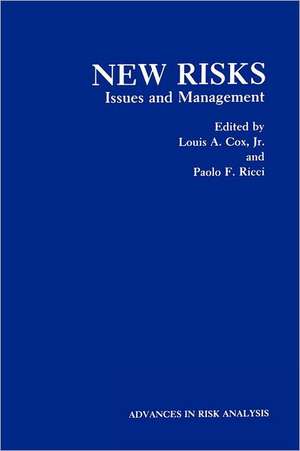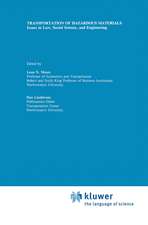New Risks: Issues and Management: Advances in Risk Analysis, cartea 6
Editat de Louis A. Cox, Paolo F. Riccien Limba Engleză Hardback – 30 sep 1990
| Toate formatele și edițiile | Preț | Express |
|---|---|---|
| Paperback (1) | 1433.46 lei 6-8 săpt. | |
| Springer Us – 8 iun 2013 | 1433.46 lei 6-8 săpt. | |
| Hardback (1) | 2146.27 lei 6-8 săpt. | |
| Springer Us – 30 sep 1990 | 2146.27 lei 6-8 săpt. |
Preț: 2146.27 lei
Preț vechi: 2259.23 lei
-5% Nou
Puncte Express: 3219
Preț estimativ în valută:
410.67€ • 431.08$ • 340.88£
410.67€ • 431.08$ • 340.88£
Carte tipărită la comandă
Livrare economică 10-24 aprilie
Preluare comenzi: 021 569.72.76
Specificații
ISBN-13: 9780306435379
ISBN-10: 0306435373
Pagini: 716
Ilustrații: XII, 716 p.
Dimensiuni: 178 x 254 x 40 mm
Greutate: 1.47 kg
Ediția:1990
Editura: Springer Us
Colecția Springer
Seria Advances in Risk Analysis
Locul publicării:New York, NY, United States
ISBN-10: 0306435373
Pagini: 716
Ilustrații: XII, 716 p.
Dimensiuni: 178 x 254 x 40 mm
Greutate: 1.47 kg
Ediția:1990
Editura: Springer Us
Colecția Springer
Seria Advances in Risk Analysis
Locul publicării:New York, NY, United States
Public țintă
ResearchCuprins
Risk Management for Controlling Pollution Liability in a Corporate Environment.- Corporate Management of Liability Risk.- The Independent Auditors’ Assessment and Conveyance of Risk (Preliminary Results).- Strict Liability and Insurance Under Loss Misestimation.- Comparison of EPA, ILO, and World Bank Guidelines for Risk Identification, Assessment, and Management of Chemical Emergencies.- Decision Analysis in Environmental Risk Management: Applications to Acid Deposition and Air Toxics.- Causality in Toxicologic Risk Assessment and Risk Management.- Environmentally Induced Cancer: A Model for Estimating Excess Cancer Risks Based on a Two-Stage Model of Carcinogenesis.- Is the One-Hit Model of Carcinogenesis Conservative? Evidence from the National Toxicology Program’s Bioassay Database.- Carcinogenicity Versus Acute Toxicity: Is There a Relationship?.- Incorporating More Science Into Cancer Dose-Response Extrapolations.- Parameters Involved in Risk Assessment for Environmental Release of Biotechnology Products.- Do Genetically Engineered Microorganisms Pose Risks to Ecosystems?.- Control of Microbial Pathogens in Poultry by Irradiation: Issues Related to Risks and Benefits.- Exposure Assessment for Sterilized Medical Devices: Implications for Microbiological Risk Analysis.- Risks in New Technologies — Controlling Toxic and Hazardous Gas Releases During Photovoltaic Cell Manufacture.- Application of Systems Analysis Techniques to Vulnerability Studies of Complex Installations.- Seismic Hazard in the Eastern United States: Bounding the Uncertainty.- Thinking the Unthinkable: Preparing for Global Disaster.- Risk Aversion in Agricultural Policy Analysis: A Closer Look at Meaning, Modeling, and Measurement.- Evaluating Risks to Agricultural Production from AcidDeposition.- Economic Principles of Risk Management in Production.- Assessing Risk from Dermal Exposure at Hazardous Waste Sites.- Bioaccumulation of TCDD in Lake Ontario Fish: Laboratory and Field Studies in Support of Hazardous Waste Landfill Risk Assessments.- Risk Assessment of Indoor Air Pollution by Termiticides.- Fuzzy Risk Analysis: Theory and Application.- Assessment of the Acceptability of the Proposals for a Fixed Link Across the English Channel.- Risk Assessment and Management: A Regional Approach.- Scientific and Technological Inputs to Nonroutine Decision Making by Three Groups: Scientists, Government Officials, Corporate Managers.- Confidence in Technologies: Interaction Between Publics and Industries.- Ritualism in Communicating Risk Information.- Summary of Panel Discussion on “The Role of Private and Public Sector Insurance and Compensation for Environmental Pollution”.- Risk Management Through Market Incentives: Liability and Insurance.- A Comparison of the Human Exposure Model and the Air Emissions Risk Assessment Model.- Comparisons Between Desktop Dispersion Calculations and Computerized Air Dispersion Model Results When Results Are to Be Used in a Risk Assessment.- Livermore Risk Analysis Methodology: A Structured Decision Analytic Tool for Information Systems Risk Management.- LAVA: A Conceptual Framework for Automated Risk Analysis.- A Probabilistic Risk Assessment Program for Analyzing Security Risks.- A General Purpose Computer Shell for Risk Analysis.- A Preliminary Model of Radon Exposure.- Power-Frequency Fields: Risk Without Measure.- Computer Security Risk Analysis.- Diffuse Risks from Adversarial Sources: An Emerging Field of Risk Analysis.- Uncertainty and Variability in Environmental Risk Assessment: A Framework for Analysis.- AnExperiment in Combining Estimates of Uncertainty.- Linear-Nonparametric Low-Dose Disease Risk Estimation.- Methods Used in Probabilistic Risk Assessment for Uncertainty and Sensitivity Analysis.- Can We Bring Quality of Management into PRAs?.- Studies with a New Risk Reduction Model.- Hits on MRS.- A Psychological Perspective on Accident Evolutions and How to Arrest Them in Nuclear Power Plants.- Chernobyl Accident — Emergency Monitoring and Protection Measures in Poland.- The Accident at Chernobyl: A Report on Risk Management at a Local Hot Spot in West Germany.- The Comparative Ranking of Risks.- Getting to Maybe: Implied Principles of Trust and Consent in Two Massachusetts Acts.- Coping with Scientific and Technological Uncertainty: Federal Policy Anlaysis for Nonroutine Decisions.- Signal Detection and Perceived Risks: Homeowner Responses to Radon Risk Information.- Role of Publicity in Three Risk Management Decisions: Ethylene Dibromide as a Pesticide, Dioxin in Times Beach, and Screening Mammography.- An Extension of the Coverage-Attitude Hypothesis: Coverage of Technological and Environmental Hazards in Dutch Newspapers and Readers’ Reactions.- Contrasting Risk Communication Tasks and Objectives for Superfund Sites, Underground Storage Tanks, and Biotechnology Field Tests.- Communicating Risk: Factors Affecting Community Acceptance of Information.- AIDS: Risks and Public Policies.- The Healthy Worker Effect: The Need to Reevaluate a Broad Spectrum of Occupational Risks.- Cultural Values Affecting Risk Perception: Individualism and the Perception of Toxicological Risks.- Are Twenty-Fold Differences in “Lifesaving” Costs Justified?: A Psychometric Study of the Relative Value Placed on Preventing Deaths from Programs Addressing Different Hazards.- TheNature of PRA for the Chemical Industry.- Risk Uncertainties in Public Sector Safety Decisions: Assessment Methods and Management Implications.- Assessment of Risks from Acute Hazards at Monsanto.- Differences Between Industries in the Definition of Acceptable Risk.- Risk Education and Hazard Management in the Workplace: The Role of Workers’ and Executives’ Social Relations.- Consumer Response to Food Risk Information: Demographic Differences.- Estimating Fatality Reductions from Increased Safety Belt Use.- Are Special Trains Really Safer?.- Comparison of Risks from Ocean-Based and Land-Based Incineration of Hazardous Wastes.- Carcinogenesis Risk Assessment of Two-Carbon Alkylating Agents Using Dynamic Simulation of Absorption and Metabolism.- Author Index.


























